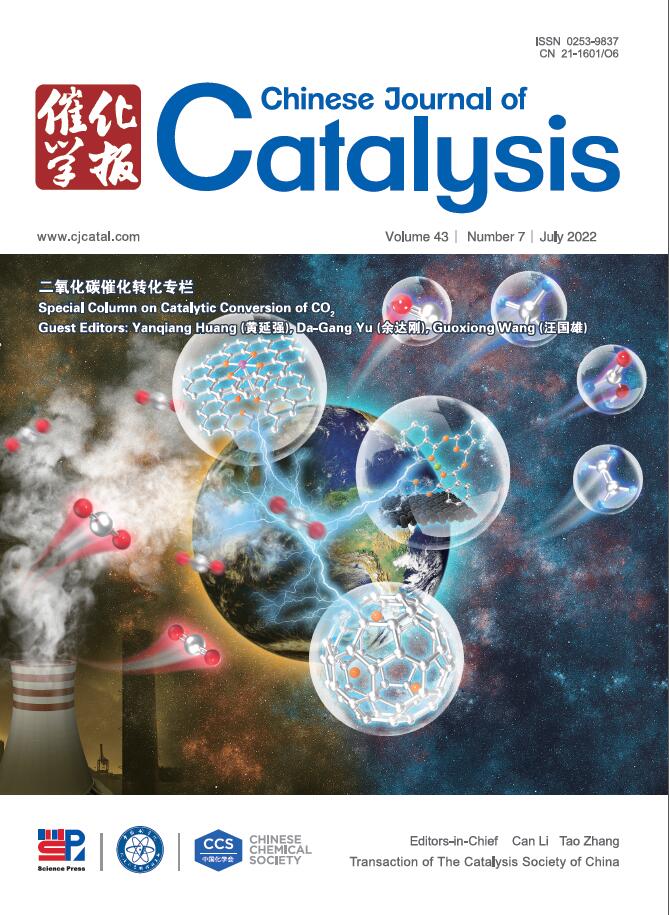The design and fabrication of TiO2/Bi4O5Br2 step-scheme heterojunctions for the photodegradation of gaseous hydrogen sulfide: DFT calculation, kinetics, pathways, and mechanisms
IF 17.7
1区 化学
Q1 CHEMISTRY, APPLIED
引用次数: 0
Abstract
ABSTRACT
It is a challenging task to efficiently convert deleterious hydrogen sulfide (H2S) into less harmful products such as SO42– species. In an effort to address such issue, a step-scheme (S-scheme) heterojunction photocatalyst has been built by concatenating TiO2 (P25) and ultrathin Bi4O5Br2 into TiO2/Bi4O5Br2 (namely, x-TB-y: x and y denote the molar ratio of TiO2:Bi4O5Br2 and pH value for solution-based synthesis, respectively) via in-situ hydrothermal method. The S-scheme charge transfer pathway in TB is confirmed by electron spin resonance and band structure analysis while experimental data and density functional theory calculations suggest the formation of an internal electric field to facilitate the separation and transfer of photoinduced charge carriers. Accordingly, the optimized heterojunction photocatalyst, i.e., 5-TB-9, showcases significantly high (> 99%) removal efficiency against 10 ppm H2S in a 17 L chamber within 12 minutes (removal kinetic rate r: 0.7 mmol·h–1·g–1, specific clean air delivery rate SCADR: 5554 L·h–1·g–1, quantum yield QY: 3.24 E-3 molecules·photon–1, and space-time yield STY: 3.24 E-3 molecules·photon–1·mg–1). Combined analysis of in-situ diffuse reflectance infrared Fourier transform adsorption spectra and gas chromatography-mass spectrometry allows to evaluate the mechanisms leading to the complete degradation of H2S (i.e., into SO42– without forming any intermediate species). This work demonstrates the promising remediation potential of an S-scheme TiO2/Bi4O5Br2 photocatalyst against hazardous H2S gas for sustainable environmental remediation.
用于光降解气态硫化氢的TiO2/Bi4O5Br2阶梯异质结的设计和制造:DFT计算、动力学、途径和机制
如何有效地将有害的硫化氢(H2S)转化为危害较小的产物(如SO42 -)是一项具有挑战性的任务。为了解决这一问题,通过原位水热法将TiO2 (P25)和超薄Bi4O5Br2连接成TiO2/Bi4O5Br2(其中x- tb -y: x和y分别表示TiO2:Bi4O5Br2的摩尔比和溶液合成的pH值),构建了阶梯结构(S-scheme)异质结光催化剂。电子自旋共振和能带结构分析证实了TB中的S-scheme电荷转移途径,实验数据和密度泛函理论计算表明,内部电场的形成促进了光诱导载流子的分离和转移。因此,优化后的异质结光催化剂,即5-TB-9,显示出显著高的(>;99%)在17 L腔室中12分钟内对10 ppm H2S的去除效率(去除动力学速率r: 0.7 mmol·h-1·g-1,特定洁净空气输送率SCADR: 5554 L·h-1·g-1,量子产率QY: 3.24 E-3分子·光子- 1,时空产率STY: 3.24 E-3分子·光子- 1·mg-1)。结合原位漫反射红外傅立叶变换吸附光谱和气相色谱-质谱分析,可以评估导致H2S完全降解的机制(即,在不形成任何中间物质的情况下,降解为SO42)。这项工作证明了S-scheme TiO2/Bi4O5Br2光催化剂对有害H2S气体的修复潜力,可用于可持续的环境修复。
本文章由计算机程序翻译,如有差异,请以英文原文为准。
求助全文
约1分钟内获得全文
求助全文
来源期刊

Chinese Journal of Catalysis
工程技术-工程:化工
CiteScore
25.80
自引率
10.30%
发文量
235
审稿时长
1.2 months
期刊介绍:
The journal covers a broad scope, encompassing new trends in catalysis for applications in energy production, environmental protection, and the preparation of materials, petroleum chemicals, and fine chemicals. It explores the scientific foundation for preparing and activating catalysts of commercial interest, emphasizing representative models.The focus includes spectroscopic methods for structural characterization, especially in situ techniques, as well as new theoretical methods with practical impact in catalysis and catalytic reactions.The journal delves into the relationship between homogeneous and heterogeneous catalysis and includes theoretical studies on the structure and reactivity of catalysts.Additionally, contributions on photocatalysis, biocatalysis, surface science, and catalysis-related chemical kinetics are welcomed.
 求助内容:
求助内容: 应助结果提醒方式:
应助结果提醒方式:


